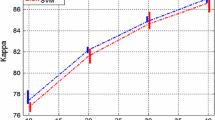Abstract
Conventional radial basis function (RBF) networks for spatial regression assume independent and identical distribution and ignore spatial information. In contrast to input fusion, we push spatial information further into RBF networks by fusing output from hidden and output layers. Three case studies demonstrate the advantage of hidden fusion over others and indicate the optimal value is around 1 for the coefficient used in hidden fusion, which links the output from the hidden layer for each site with their neighbors.
Similar content being viewed by others
Abbreviations
- RBF:
-
Radial Basis Function
- MSE:
-
Mean Squared Error
- iid:
-
independent and identical distribution
- IF:
-
Input Fusion
- HF:
-
Hidden Fusion
- OF:
-
Output Fusion
References
C. Ambroise G. Govaert (1998) ArticleTitleConvergence of an EM-type algorithm for spatial clustering Pattern Recognition Letters 19 IssueID10 919–927
L. Anselin (1988) Spatial Econometrics: Methods and Models Kluwer Academic Publishers Dordrecht
C. M. Bishop (1995) Neural Networks for Pattern Recognition Oxford University Press Dordrecht
A. De Carvalho M. M. Brizzotti (2001) ArticleTitleCombining RBF networks trained by different clustering techniques Neural Processing Letters 14 227–240
N. A. Cressie (1993) Statistics for Spatial Data Wiley New York
Ester, M., Kriegel, H. P. and Sander, J.: Spatial data mining: A database approach, In:Proceedings of 5th Symposium on Spatial Databases: 47–66, 1997.
S. Geman D. Geman (1984) ArticleTitleStochastic relaxation, gibbs distributions and the bayesian restoration of images IEEE Transactions on Pattern Analysis and Machine Intelligence 6 721–741
N. Gilardi S. Bengio (2000) ArticleTitleLocal machine learning models for spatial data analysis Journal of Geographic Information and Decision Analysis 4 IssueID1 11–28
O. W. Gilley R. K. Pace (1996) ArticleTitleOn the harrison and rubinfeld data Journal of Environmental Economics and Management 31 403–405
D. Harrison D. L. Rubinfeld (1978) ArticleTitleHedonic prices and the demand for clean air Journal of Environmental Economics and Management 5 81–102
E. J. Hartman J. D. Keller J. M. Kowalski (1990) ArticleTitleLayered neural networks with gaussian hidden units as universal approximations Neural Computation 2 IssueID2 210–215
T. Hastie R. Tibshirani J. Friedman (2001) Elements of Statistical Learning: Data Mining Inference and Prediction Springer-Verlag, Berlin
Hermes, L. and Buhmann, J. M.: Contextual classification by entropy-based polygonization, In: Proceedings of the IEEE Conference on Computer Vision and Pattern recognition 2001, 442–447.
A. K. Jain F. Farrokhnia (1991) ArticleTitleUnsupervised texture segmentation using gabor filters Pattern Recognition 24 IssueID12 1167–1186
Y. Jhung P. H. Swain (1996) ArticleTitleBayesian contextural classification based on modified m-estimates and markov random fields IEEE Transactions on Geoscience and Remote Sensing 34 IssueID1 67–75
L Kaufman P.J. Rousseeuw (1990) Finding Groups in Data: An Introduction to Cluster Analysis Wiley New York
Legendre, P.: Constrained clustering, In: Developments in Numerical Ecology, 289–307, NATO ASI Series G 14, (1987).
LeSage, J. P.: MATLAB Toolbox for Spatial Econometrics, http: //www.spatial-econometrics.com, 1999.
H. Leung G. Hennessey A. Drosopoulos (2000) Signal detection using the radial basis function coupled map lattice, IEEE Transactions on Neural Networks 11 IssueID5 1133–1151
M. A. Oliver R. Webster (1989) ArticleTitleA geostatistical basis for spatial weighting in multivariate classification Mathematical Geology 21 15–35
R. K. Pace R. Barry (1997) ArticleTitleQuick computation of spatial autoregressive estimators Geographical Analysis 29 232–247
T. Poggio F. Girosi (1990) ArticleTitleNetworks for approximation and learning Proceedings of the IEEE 78 IssueID9 1481–1497
Powell, M. J. D.: Radial basis functions for multivariable interpolation: A review, In: Algorithms for Approximation, 143–167, Clarendon Press, Oxford, (1987).
Shekhar, S. and Chawla, S.: Spatial Databases: A Tour, Prentice-Hall, 2002.
B. W. Silverman (1986) Density Estimation for Statistics and Data Analysis Chapman & Hall London
A. H. Solberg T. Taxt A. K. Jain (1996) ArticleTitleA markov random field model for classification of multisource satellite imagery IEEE Transactions on Geoscience and Remote Sensing 34 IssueID1 100–113
Y. Yan (1999) ArticleTitleUnderstanding speech recognition using correlation-generated neural network targets IEEE Transactions on Speech and Audio Processing 7 IssueID3 350–352
Author information
Authors and Affiliations
Corresponding author
Rights and permissions
About this article
Cite this article
Hu, T., sung, S.Y. Data Fusion in Radial Basis Function Networks for Spatial Regression. Neural Process Lett 21, 81–93 (2005). https://doi.org/10.1007/s11063-004-7776-5
Issue Date:
DOI: https://doi.org/10.1007/s11063-004-7776-5




